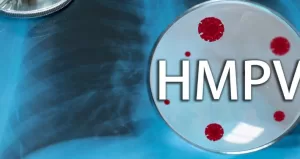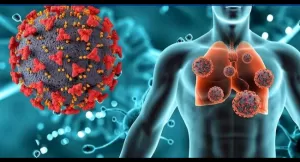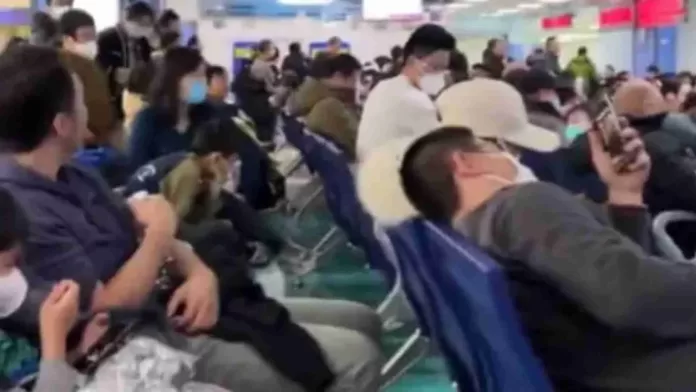The federal government has announced plans to activate surveillance measures for inbound passengers from China following the current surge of respiratory virus.
According to reports, the virus, attributed to the Human Metapneumovirus, has seen cases spiking across northern Chinese provinces this winter, particularly among children. Neighbouring countries such as Cambodia, Taiwan, and Hong Kong are closely monitoring the HMPV situation, having reported a few cases but no widespread outbreaks. Social media posts, accompanied by videos of overcrowded hospitals, have sparked fears of a larger-scale health crisis.
Reports indicate that the virus has led to overcrowded hospitals, emergency measures and public concerns in China.
Chinese authorities said, this virus, called Human Metapneumovirus (HMPV), is spreading in northern China, especially among children this winter. While nearby countries like Cambodia, Taiwan, and Hong Kong have seen a few cases, they haven’t had major outbreaks.
The Chinese authorities have noticed more HMPV cases in children under 14 in northern China. People have been sharing videos of crowded hospitals on social media, making others worried about a possible health crisis.
China is fighting back by watching case numbers and telling people to wear masks, keep their distance from others, and clean public spaces.
In response to the rising cases, the Chinese government announced measures, including constant monitoring of cases, the adoption of masks, social distancing and disinfection of public spaces to curb the increase of the virus.
The new virus outbreak is coming five years after the emergence of a novel coronavirus (COVID-19), in Wuhan, China, which was declared a global pandemic by the World Health Organisation on March 11, 2020.
The World Health Organisation says COVID-19 has infected 777 million people and killed over seven million worldwide.
While both HMPV and COVID-19 affect breathing, they’re different. HMPV usually causes milder symptoms like a cold or flu, while COVID-19 can be more serious. HMPV typically shows up in winter, like other cold viruses.

However, while both HMPV and COVID-19 are respiratory illnesses, there are important differences. HMPV typically causes milder symptoms such as a cold or flu, while COVID-19, caused by the SARS-CoV-2 virus, can lead to more severe health complications and long-term effects.
HMPV is also a seasonal virus, similar to other cold-causing pathogens like RSV, and infections usually peak during the winter months. HMPV, like COVID-19, spreads through respiratory droplets when an infected person coughs or sneezes and it can also spread via contaminated surfaces.
This virus, called Human Metapneumovirus (HMPV), is spreading in northern China, especially among children this winter. While nearby countries like Cambodia, Taiwan, and Hong Kong have seen a few cases, they haven’t had major outbreaks.
The Chinese authorities have noticed more HMPV cases in children under 14 in northern China. People have been sharing videos of crowded hospitals on social media, making others worried about a possible health crisis.
China is fighting back by watching case numbers and telling people to wear masks, keep their distance from others, and clean public spaces. This outbreak is happening five years after COVID-19 first appeared in Wuhan, China. The World Health Organisation says COVID-19 has infected 777 million people and killed over seven million worldwide.
However, while both HMPV and COVID-19 are respiratory illnesses, there are important differences. HMPV typically causes milder symptoms such as a cold or flu, while COVID-19, caused by the SARS-CoV-2 virus, can lead to more severe health complications and long-term effects.
HMPV is also a seasonal virus, similar to other cold-causing pathogens like RSV, and infections usually peak during the winter months. HMPV, like COVID-19, spreads through respiratory droplets when an infected person coughs or sneezes and it can also spread via contaminated surfaces.
However, officials from the National Health Commission stated that while respiratory diseases are expected to rise during the winter months, the overall situation this year is less severe than last year.
The US Centers for Disease Control and Prevention said, HMPV could cause upper and lower respiratory diseases in people of all ages, especially among young children, older adults and people with weakened immune systems.
The U.S CDC noted that HMPV is most likely spread from an infected person to others through secretions from coughing and sneezing, close personal contact and touching objects or surfaces that have the viruses on them, then touching the mouth, nose, or eyes.
“Symptoms commonly associated with HMPV include cough, fever, nasal congestion and shortness of breath. Clinical symptoms of HMPV infection may progress to bronchitis or pneumonia and are similar to other viruses that cause upper and lower respiratory infections. The estimated incubation period is three to six days, and the median duration of illness can vary, depending upon severity but is similar to other respiratory infections caused by viruses,” the US CDC stated.
Meanwhile, health authorities in Nigeria are already implementing emergency measures to monitor and manage the spread of the HMPV.
The Director, Special Duties, Office of the Director-General of the Nigeria Centre for Disease Control and Prevention, Dr John Oladejo, stated that the Federal Government would implement preventive measures by activating surveillance measures to curb the spread of the virus.

READ ALSO: US Issues ‘Do Not Travel’ Advisory For 7 African Countries
“The FG will activate surveillance measures, like quarantine, for passengers coming in from China,” Dr Oladejo said.
A virologist at the Department of Virology, College of Medicine, University College Hospital, Ibadan, Dr Moses Adewumi said, “On good day, surveillance should always be part of us. What happens most times is that despite the amount that was voted for COVID-19, we seem to have relaxed. Our people are more interested in spending the money, and after that, we probably decide to go to sleep. So, the surveillance should be a continuous thing.
“It is good that we increase our surveillance for people coming into the country, especially from China, Japan and other places, where we have the outbreaks. The government should be more involved in surveillance because most of the surveillance and all the research we do is funded by foreign bodies, so our own government should be more interested in research, in surveillance for all these viruses.
“The virus is not new but the surge may be because there is a different variant, and that is why we need to increase our surveillance and monitor it closely to curtail its introduction into the country. Experience has taught us that if we check now, we may have our people with antibodies already, and that’s a confirmation that it’s likely that this is circulating here, maybe not the exact variants that they have now.”
Also, an Associate Professor of Infectious Diseases and Genomics in the Department of Microbiology at the Adeleke University, Osun State, Oladipo Kolawole, noted that the decision by the government to implement surveillance measures was a good one, adding that it aimed to monitor and control the potential spread of the virus, ensuring public health safety as the situation developed.
Kolawole said, “The government is likely to enhance screening processes at points of entry and provide guidelines for travellers from China, this is to mitigate risks associated with HMPV. Activating surveillance allows for the early detection of cases, which is essential in managing outbreaks effectively. Monitoring travellers from regions experiencing outbreaks can help identify and isolate cases before they spread within the community.
“Also, quarantine for inbound passengers from the affected regions can significantly reduce the risk of transmission. It serves as a precautionary measure to ensure that individuals who may be infected do not unknowingly spread the virus to others. Finally, this situation underscores the importance of preparedness in public health systems.”

